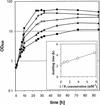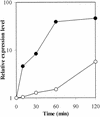The phosphate starvation stimulon of Corynebacterium glutamicum determined by DNA microarray analyses
- PMID: 12867461
- PMCID: PMC165763
- DOI: 10.1128/JB.185.15.4519-4529.2003
The phosphate starvation stimulon of Corynebacterium glutamicum determined by DNA microarray analyses
Abstract
The phosphate (P(i)) starvation stimulon of Corynebacterium glutamicum was characterized by global gene expression analysis by using DNA microarrays. Hierarchical cluster analysis of the genes showing altered expression 10 to 180 min after a shift from P(i)-sufficient to P(i)-limiting conditions led to identification of five groups comprising 92 genes. Four of these groups included genes which are not directly involved in P metabolism and changed expression presumably due to the reduced growth rate observed after the shift or to the exchange of medium. One group, however, comprised 25 genes, most of which are obviously related to phosphorus (P) uptake and metabolism and exhibited 4- to >30-fold-greater expression after the shift to P(i) limitation. Among these genes, the RNA levels of the pstSCAB (ABC-type P(i) uptake system), glpQ (glycerophosphoryldiester phosphodiesterase), ugpAEBC (ABC-type sn-glycerol 3-phosphate uptake system), phoH (unknown function), nucH (extracellular nuclease), and Cgl0328 (5'-nucleotidase or related esterase) genes were increased, and pstSCAB exhibited a faster response than the other genes. Transcriptional fusion analyses revealed that elevated expression of pstSCAB and ugpAEBC was primarily due to transcriptional regulation. Several genes also involved in P uptake and metabolism were not affected by P(i) starvation; these included the genes encoding a PitA-like P(i) uptake system and a putative Na(+)-dependent P(i) transporter and the genes involved in the metabolism of pyrophosphate and polyphosphate. In summary, a global, time-resolved picture of the response of C. glutamicum to P(i) starvation was obtained.
Figures




Similar articles
-
Regulation of the pstSCAB operon in Corynebacterium glutamicum by the regulator of acetate metabolism RamB.BMC Microbiol. 2015 May 29;15:113. doi: 10.1186/s12866-015-0437-1. BMC Microbiol. 2015. PMID: 26021728 Free PMC article.
-
The pstSCAB operon for phosphate uptake is regulated by the global regulator GlxR in Corynebacterium glutamicum.J Biotechnol. 2011 Jul 10;154(2-3):149-55. doi: 10.1016/j.jbiotec.2010.07.015. Epub 2010 Jul 16. J Biotechnol. 2011. PMID: 20638427
-
The DtxR protein acting as dual transcriptional regulator directs a global regulatory network involved in iron metabolism of Corynebacterium glutamicum.BMC Genomics. 2006 Feb 9;7:21. doi: 10.1186/1471-2164-7-21. BMC Genomics. 2006. PMID: 16469103 Free PMC article.
-
Molecular Mechanisms of Phosphate Sensing, Transport and Signalling in Streptomyces and Related Actinobacteria.Int J Mol Sci. 2021 Jan 23;22(3):1129. doi: 10.3390/ijms22031129. Int J Mol Sci. 2021. PMID: 33498785 Free PMC article. Review.
-
Genome-wide transcription profiling of Corynebacterium glutamicum after heat shock and during growth on acetate and glucose.J Biotechnol. 2002 Sep 25;98(2-3):255-68. doi: 10.1016/s0168-1656(02)00136-0. J Biotechnol. 2002. PMID: 12141991 Review.
Cited by
-
Link between phosphate starvation and glycogen metabolism in Corynebacterium glutamicum, revealed by metabolomics.Appl Environ Microbiol. 2010 Oct;76(20):6910-9. doi: 10.1128/AEM.01375-10. Epub 2010 Aug 27. Appl Environ Microbiol. 2010. PMID: 20802079 Free PMC article.
-
Phosphate control of the biosynthesis of antibiotics and other secondary metabolites is mediated by the PhoR-PhoP system: an unfinished story.J Bacteriol. 2004 Aug;186(16):5197-201. doi: 10.1128/JB.186.16.5197-5201.2004. J Bacteriol. 2004. PMID: 15292120 Free PMC article. Review. No abstract available.
-
Harnessing phosphate-solubilizing microorganisms for mitigation of nutritional and environmental stresses, and sustainable crop production.Planta. 2025 Mar 25;261(5):95. doi: 10.1007/s00425-025-04669-2. Planta. 2025. PMID: 40131541 Review.
-
The alternative sigma factor SigB of Corynebacterium glutamicum modulates global gene expression during transition from exponential growth to stationary phase.BMC Genomics. 2007 Jan 4;8:4. doi: 10.1186/1471-2164-8-4. BMC Genomics. 2007. PMID: 17204139 Free PMC article.
-
Quinone-dependent D-lactate dehydrogenase Dld (Cg1027) is essential for growth of Corynebacterium glutamicum on D-lactate.BMC Microbiol. 2010 Dec 15;10:321. doi: 10.1186/1471-2180-10-321. BMC Microbiol. 2010. PMID: 21159175 Free PMC article.
References
-
- Aguena, M., E. Yagil, and B. Spira. 2002. Transcriptional analysis of the pst operon of Escherichia coli. Mol. Genet. Genomics 268:518-524. - PubMed
-
- Akiyama, M., E. Crooke, and A. Kornberg. 1993. An exopolyphosphatase of Escherichia coli. The enzyme and its ppx gene in a polyphosphate operon. J. Biol. Chem. 268:633-639. - PubMed
-
- Andersen, A. B., L. Ljungqvist, and M. Olsen. 1990. Evidence that protein antigen b of Mycobacterium tuberculosis is involved in phosphate metabolism. J. Gen Microbiol. 136:477-480. - PubMed
-
- Arfin, S. M., A. D. Long, E. T. Ito, L. Tolleri, M. M. Riehle, E. S. Paegle, and G. W. Hatfield. 2000. Global gene expression profiling in Escherichia coli K12. The effects of integration host factor. J. Biol. Chem. 275:29672-29684. - PubMed
Publication types
MeSH terms
Substances
LinkOut - more resources
Full Text Sources
Other Literature Sources
Molecular Biology Databases
Research Materials
Miscellaneous

